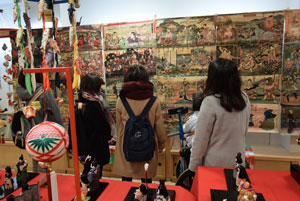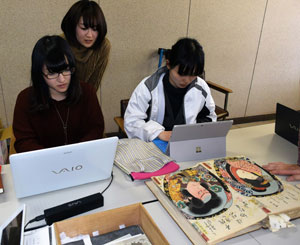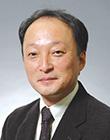Top>Research>Hina Dolls Surrounded by Ukiyo-e Art and Ukiyo-e Art Protected by Hina Dolls
 Index
Index
Hina Dolls Surrounded by Ukiyo-e Art and Ukiyo-e Art Protected by Hina Dolls
Toshiyuki Suzuki
Professor, Faculty of Letters, Chuo University
Area of Specialization: Early Modern Japanese Literature
It has been more than 20 years since I started visiting the town of Ojiya, which was once part of ancient Echigo Province. I have had a long relationship with the area. For a three-day period starting from March 3rd of this year, I visited the town in order to conduct survey. I will continue to conduct biannual surveys in Ojiya every March and August. The purpose of this survey is to assess ukiyo-e art. Although I use the term survey, obtaining academic results is not the primary goal. More than anything, this is evidenced by how I have never written any academic papers based on my surveys, despite my frequent visits to the area. Each one of my visits entails fairly large surveys which involve a great number of people. My surveys are not subsidized by JSPS KAKENHI or any other grants, and participants all volunteer to do the surveys. Most likely, these surveys, which are not aimed at results, will continue in the same format far into the future.
In Ojiya, ukiyo-e is called e-gami. Ojiya is a rare town where a rich amount of e-gami still remains. The culture of e-gami is greatly influenced by the custom of the Doll Festival (Hina Matsuri in Japanese). In Ojiya, it is common for the walls of Hina doll rooms to be covered with e-gami. About four or five series of triptych Nishiki-e are joined together to form a wall-mounted tapestry that is affixed to all surfaces of a four-walled room. This creates a gorgeous atmosphere. As one type of Hina goods, e-gami has been stored together with Hina dolls by households in Ojiya.

Hina decorations in Yamada-ya, a kimono store
Ojiya is a region that is blessed with water transportation via the Shinano River, making it one of the main transportation routes in Echigo. Ojiya was a trading center for goods such as specially-produced crepe fabric and woven hemp cloth. Crepe fabric wholesalers, leader of the economic development of Ojiya, used to be a bridge to Edo, which indicates that ukiyo-e, a popular souvenir from Edo at the time, is thought to have been naturally brought to Ojiya through commerce. This conjecture on history is greatly aided by how venerable Ojiya households that had operated crepe fabric wholesalers in Hon-cho put extremely well-preserved and exquisite ukiyo-e into picture albums. To conjecture further, ukiyo-e which was considered unworthy of careful preservation (including souvenirs from other households) was tailored into decorations for the Doll Festival. Upon shifting from the end of the Edo shogunate into the Meiji Period, it seems that this custom spread throughout the entire town of Ojiya, becoming deeply entrenched in the region and continuing until today. In the Meiji Period, spurred by the popularity of ukiyo-e in foreign countries, ukiyo-e brokers traveled throughout Japan, buying up ukiyo-e remaining in different regions. However, the ukiyo-e in Ojiya escaped this fate. A major factor in how Ojiya retained its ukiyo-e was that the art was only brought out once per year for decoration together with Hina dolls. Most likely, no one even thought of trying to sell cute decorations which were used in holding a festival for women and children. Furthermore, ukiyo-e which had been joined together using the crude techniques of amateurs were probably lacking in product appeal. In other words, venerable Hina dolls have protected ukiyo-e and the corresponding culture.
My relationship with Ojiya began one day more than 20 years ago, when I received an unexpected phone call from Kineya Yoshimaru, a performer of nagauta (long epic Japanese songs). Kineya stated that he had found something strange and wanted me to come to Ojiya to investigate. It seemed that Kineya had found something during one of his frequent visits to Ojiya for practice. From the phone call, I had absolutely no idea of what he had found or what was so strange. However, feeling guilty about my complete lack of knowledge regarding nagauta, I quickly accepted his request. It was obvious that my main interest was enjoying good liquor and delicious food with Kineya. Together with Dr. Kenji Watanabe, who was Professor of Rikkyo University and also unfamiliar with nagauta, I was taken by Kineya and his wife to the Hyokyu Yokoyama Paperhanging Shop in Ojiya. At the shop, I was shown a series of ukiyo-e which had been joined into a vertical hanging. The Yokoyama family had more than 20 hangings comprised of more than 300 ukiyo-e pictures. I was astonished. Furthermore, I was surprised by these hangings not been treated with special care; rather, they appeared to have been carelessly folded and stacked. Mr. Kyuichiro Yokoyama, the proprietor of the shop, informed me that many households in Ojiya possessed similar hangings. Once again, I was astonished—although I now understood why the hangings had been handled so carelessly.
Upon talking more with Mr. Yokoyama, I learned that many households used new Hina dolls to replace old dolls which were difficult to handle. These old dolls are left in storage together with e-gami used as decorations. Recently, many people are even unaware of the existence of these dolls and e-gami. Not only are these e-gami, now dusty and soiled, not treated with the care that they deserve, they are sometimes thrown away to free up storage space. Mr. Yokoyama had even heard of people who burnt the e-gami in their farm fields. Furthermore, many people today tear down their warehouses to build new residences. Naturally, these unneeded and dirty parcels of paper are thrown away.
More than anything, I want to emphasize that these ukiyo-e are a familiar item in Ojiya. Since long ago, the ukiyo-e have continually been treated with fondness and integrated into people’s everyday life. Ukiyo-e as decorations for the Doll Festival are unusual, but what is extremely valuable is the fact that these ukiyo-e have existed in places easily accessed by any person and are not experienced as works of art in museums or at exhibitions. This situation is identical to the one in the Edo Period. On the other hand, everyday items are not given much consideration. During the flow of everyday life, no one notices when the ukiyo-e are no longer present, and both the ukiyo-e and corresponding culture are lost.

Scene from this year’s survey
In this respect, I felt a strong sense of crisis regarding how these ukiyo-e are being scattered and lost due to being too commonplace, and how the inheritance of corresponding culture is being discontinued due to ukiyo-e’s dissipation. Therefore, I decided to perform surveys in which I investigate and catalog the e-gami stored in each household. Through these research-like activities, I hoped to raise awareness regarding the value of the e-gami. Mr. Yokoyama was immediately receptive to this project and formed the E-gami Preservation Association in Ojiya. The association was formed through membership of boisterous heavy drinkers from Ojiya, and the meetings were very lively. In truth, I returned to my hotel completely inebriated after most meetings. Based on the promise of good liquor and delicious food, I recruited new members and held surveys several times per year. Also, every year, I have planned events such as exhibitions and lectures for raising local awareness toward ukiyo-e. Through my work, I have gradually rebuilt awareness toward e-gami culture. Our events are filled with the nostalgic voices of elderly visitors reflecting on past Doll Festivals, and with the sighs of excitement of young people who are thrilled at encountering e-gami for the first time. These responses slowly fostered the awareness of e-gami culture.
During my involvement with the region, a major earthquake struck in October 2004. The epicenter was located directly beneath the town and resulted in tremors that seemed to lift the ground straight upwards. The earthquake inflicted severe damage on warehouses which held Hina dolls and e-gami. A large number of e-gami were destroyed or lost. However, the e-gami which were somehow saved became treated with much more respect. Afterwards, the E-gami Preservation Association received a series of donations and entrustments of e-gami. Unexpectedly, the tragic earthquake caused a sudden increase in awareness toward local cultural assets and culture. There are no longer any people who throw away e-gami as waste paper. Today, Ojiya City holds annual events for e-gami together with the Doll Festival.
This year, the Faculty of Letters will borrow e-gami and Hina dolls to replicate the Ojiya Hina Festival at Chuo University from March 22 (Wed.) to April 7 (Fri.). This event is a wonderful place for taking photographs to commemorate graduation or enrollment. The e-gami exhibited at our event have long been witnesses to smiles of festival goers, and visitors are welcome to take as many photographs as they please.
- Toshiyuki Suzuki
Professor, Faculty of Letters, Chuo University
Area of Specialization: Early Modern Japanese Literature - Toshiyuki Suzuki was born in Hokkaido in 1956. He graduated from the Faculty of Letters, Chuo University in 1979 and went on to complete the Master’s Program at Chuo University Graduate School of Letters. In 1981, he completed the required courses for the Doctoral Program in the same school, finishing without a degree.
After serving as a full-time lecturer at Kokushikan Junior College and a full-time lecturer and assistant professor in the Chuo University Faculty of Letters, he assumed his current position in 1998. He currently studies early-modern Japanese book culture as a whole—primarily from the standpoint of book distribution—to better understand the period from its cultural foundations. He received the Japan Society of Publishing Studies Award in 2005 and the Gesner Award in 2008.
His publications include Love of Reading in Edo Period: Self-Taught Readers and the Distribution of Books [Edo no Dokusho Netsu: Jigaku Suru Dokusha to Shoseki Ryūtsū] (Heibonsha Sensho series, Heibonsha, 2007), Bibliography of Research on Early-Modern Books (Revised and Extended Edition) [Zōho Kaitei Kinsei Shoseki Kenkyū Bunken Mokuroku] (Perikansha Publishing, 2007), Picture-Book Stores: Shops Selling Ukiyo-e Prints in Edo Period [Ezōshiya: Edo no Ukiyo-e Shoppu] (Heibonsha, 2010), All Kinds of Books in Edo Period: The State of Publishing in Edo Revealed in Kibyōshi Picture Books [Edo no Hon Zukushi: Kibyōshi de Yomu Edo no Shuppan Jijō] (Heibonsha, 2011), Juzaburo Tsutaya (New Edition) [Shinban Tsutaya Jūzaburō] (Heibonsha, 2012), The Study of Historical Materials on the Distribution of Books: An Introduction [Shoseki Ryūtsū Shiryō Ron Josetsu] (Bensei Publishing, 2012) and more.
- Research Activities as a Member of Research Fellowship for Young Scientists (DC1), Japan Society for the Promotion of Science (JSPS) Shuma Tsurumi
- Important Factors for Innovation in Payment Services Nobuhiko Sugiura
- Beyond the Concepts of Fellow Citizens and Foreigners— To Achieve SDGs Goal 10 “Reduce Inequality Within and Among Countries” Rika Lee
- Diary of Struggles in Cambodia Fumie Fukuoka
- How Can We Measure Learning Ability?
—Analysis of a Competency Self-Assessment Questionnaire— Yu Saito / Yoko Neha - The Making of the Movie Kirakira Megane









